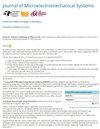耗尽层传导式微机电谐振器中的参量放大技术
IF 2.5
3区 工程技术
Q2 ENGINEERING, ELECTRICAL & ELECTRONIC
引用次数: 0
摘要
本文介绍了一种利用参数效应放大和增强耗尽层换能器全宽半最大值的方法。该装置可以用作滤波放大器,也可以用作传感器的低噪声读出方法。参数激励显示设备阻抗显著下降,从没有泵信号的334.2 k $\Omega $到300 mV泵信号的45.9 k $\Omega $。在没有泵浦信号的情况下,在输入功率为−10 dBm的情况下,谐振器在400 kHz时产生−44.87 dBm的输出功率,频宽值为23 Hz。然而,当一个200 mV的$2f_{0}$相移$\pi $ /2的泵浦信号与相同的输入功率叠加时,谐振器的输出功率放大到- 11.49 dBm, FWHM值大幅降低到10 Hz。这导致33.58 dBm的放大和2.3倍的改进Q归因于参数效应。给出了换能器的详细分析模型。[2024-0061]本文章由计算机程序翻译,如有差异,请以英文原文为准。
Parametric Amplification in Depletion Layer Transduced Microelectromechanical Resonator
This paper introduces a method for signal amplification and enhancement of full width half maxima (FWHM) in a depletion layer-transduced flexural resonator using the parametric effect. The device can be used as a filter-amplifier, or as a low-noise readout method for sensors. Parametric excitation shows a significant drop in device impedance, from 334.2 k
$\Omega $
without a pump signal to 45.9 k
$\Omega $
with a 300 mV pump signal. In the absence of the pump signal, with an input power of −10 dBm, the resonator produces an output power of −44.87 dBm at ~400 kHz and a FWHM value of 23 Hz. However, when a 200 mV pump signal at
$2f_{0}$
with
$\pi $
/2 phase shift, is superimposed with the same input power, the resonator’s output power amplifies to −11.49 dBm, and the FWHM value substantially decreases to 10 Hz. This leads to a 33.58 dBm of amplification and 2.3x improvement in Q attributed to the parametric effect. A detailed analytical model of the transducer is presented. [2024-0061]
求助全文
通过发布文献求助,成功后即可免费获取论文全文。
去求助
来源期刊

Journal of Microelectromechanical Systems
工程技术-工程:电子与电气
CiteScore
6.20
自引率
7.40%
发文量
115
审稿时长
7.5 months
期刊介绍:
The topics of interest include, but are not limited to: devices ranging in size from microns to millimeters, IC-compatible fabrication techniques, other fabrication techniques, measurement of micro phenomena, theoretical results, new materials and designs, micro actuators, micro robots, micro batteries, bearings, wear, reliability, electrical interconnections, micro telemanipulation, and standards appropriate to MEMS. Application examples and application oriented devices in fluidics, optics, bio-medical engineering, etc., are also of central interest.
 求助内容:
求助内容: 应助结果提醒方式:
应助结果提醒方式:


